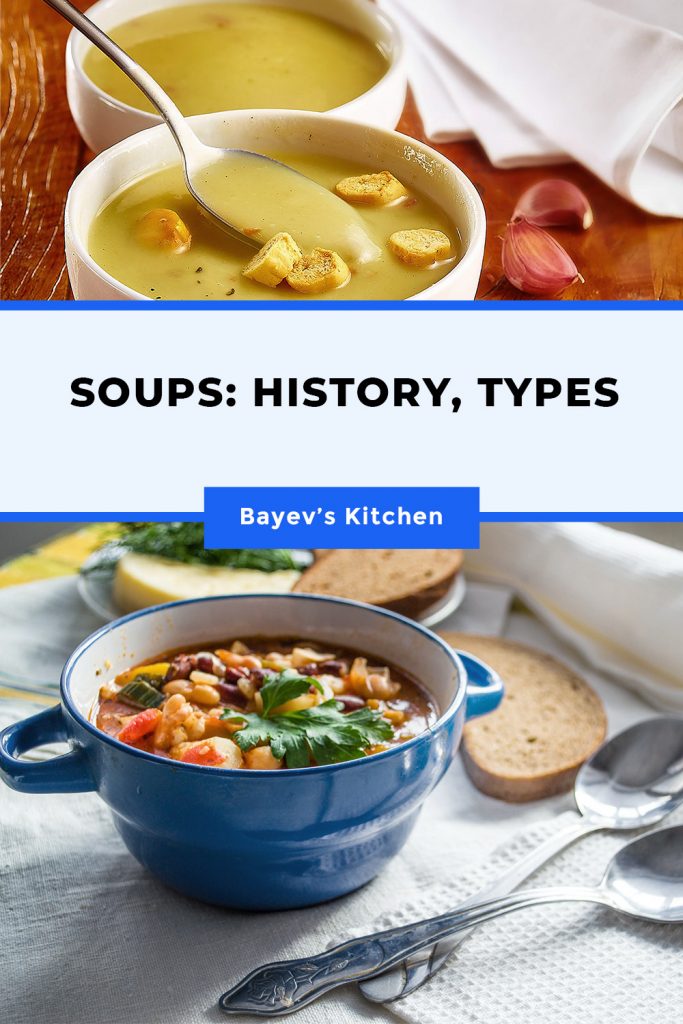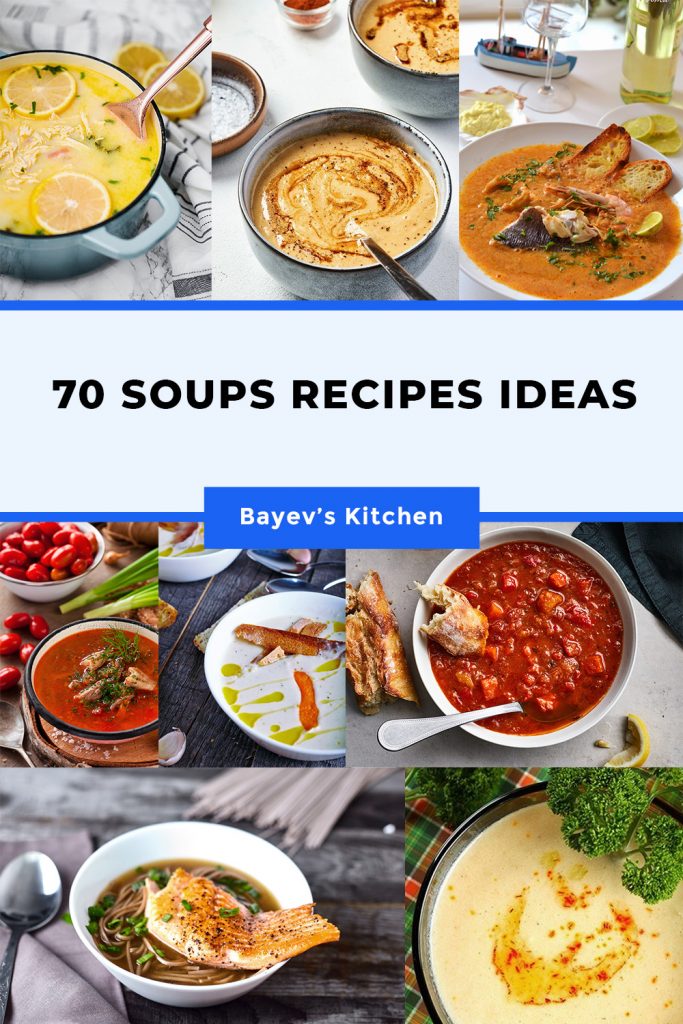Soup is a dish that contains about 50 % liquid.
Soup is an important part of human food. It is a source of energy and material for building body organs and tissues. Soup contains many dissolved proteins, fats, carbohydrates and nutrients that are easily digested and well absorbed by the body.
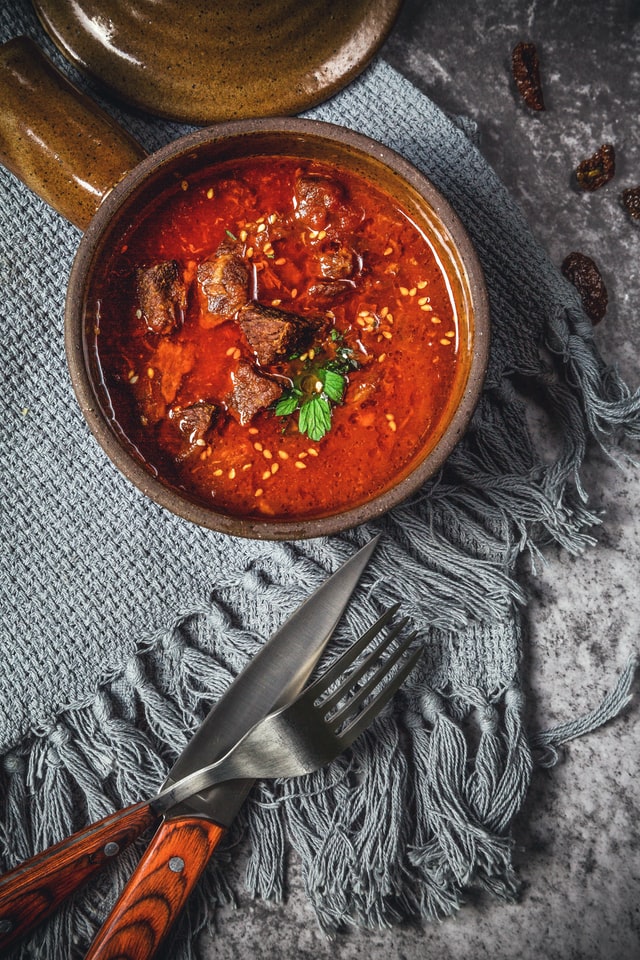
Soups stimulate the appetite and improve intestinal function. Soups are essential fibre for everyone. An adult can do without soup if he or she eats enough vegetables – raw, steamed or stewed.
Soups are indispensable for some stomach problems. Light vegetable soups stimulate digestion twice as much as hydrochloric acid treatment. Meat and chicken soups help with low gastric acidity and have a positive effect on gastric mucous glands. But for ulcers and gastritis, fatty meat soups should be avoided completely.
Chicken soup is considered dietary. It helps with colds – it contains ingredients with anti-inflammatory properties. Fish soup is full of micronutrients and easy to digest. Vegetarian soups are the most healthy of all the first courses. Such soups contribute to purification of organism and lower cholesterol level. Mashed puree soups are useful for inflammation of the stomach mucous membranes.
The first broth from meat or poultry must be drained. The first broth concentrates all harmful substances during cooking. Only the second broth is dietary. Children should be given this broth. Put vegetables in the boiling broth – less destroyed vitamin C. And carrots are useful to pass – then better absorbed carotene. Warming soups destroys all water-soluble vitamins – especially vitamin C. This reduces the nutritional value of the soup considerably.
Origins of Soup
The word soup comes from the Latin word “suppa”. It means “bread soaked in broth”.
In ancient times, liquid dishes were called chowder.
The history of soup has two opinions. The first is that soup arose with the advent of mankind in the form of a soup made from mashed grains of various plants. The other is that soup began to be made with the advent of fire. Neanderthals hung their skins over a fire and cooked the stew with the addition of water.
Later, ancient cooks began to add vegetables and spices that grew in the wild. The first recipe for soup was discovered by archaeologists in a 4th century BC book by the ancient Greek philosopher Epicurus. It included wheat, meat from wild animals, spices and fish sauce.
With the development of cookery came thick soups made from pureed vegetables, nuts and meat (puree soup). In medieval warriors, a popular stew was pea soup with lard, meat, frozen cabbage and cheese.
This dish appeared in Europe in the 14th century. It was served in bowls. The ingredients were eaten with the hands and the liquid was drunk. At the beginning of the fifteenth century, cutlery in the form of a knife and a long-handled deep spoon appeared, which were used to serve the table when the liquid meal was served. It was during this period that broth came to be known as soup. The soup was called soup, and the soup was served with a long-handled spoon and a knife.
In the 16th century, pasta – vermicelli and noodles – began to be used instead of cereals to make soup. In the Americas, at the beginning of the 20th century, cooks invented the use of semi-finished products made from various concentrates. This novelty became popular and spread to other countries.
The invention of metal utensils has influenced the ability of countries around the world to extend the conditions for preparing soups and increase their recipe.
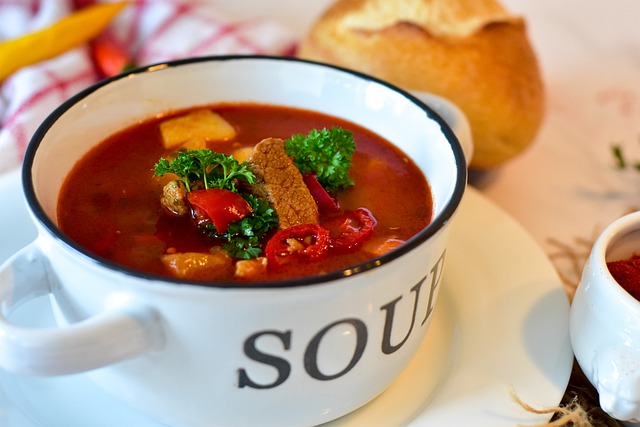
There are more than 150 types of first courses in modern cooking. They are divided into two main types – winter and summer dishes. There are more than a thousand types of first courses, and each type can have several variations.
Soup Cooking Technology
Soup technology has many variations. But there are general principles for almost all hot soups.
- A small amount of cooking. A soup cooked in a small volume tastes better than one cooked in a larger volume.
- Balancing the amount of liquid and the amount of grounds. It varies for different soups. This amount of liquid must be taken at once, taking into account the boiling out. Water must not be added to the soup or poured out during the cooking process.
- The soup should be made with the cooking time in mind. Each product in the soup must not lose its flavour and must be cooked to perfection.
- Constant checking of the cooking process. Continuously skim the foam (after each ingredient has been added), checking the boiling point, the temperature of the soup and sampling.
- The salt should be added to the soup in a timely manner. As a general rule of thumb, you should only salt the soup at the end of cooking. This allows the soup components to absorb a sufficient amount of salt.
- Moderate simmering of the soup during cooking. It is better to let the soup simmer rather than simmer during cooking.

Types of Soups
The name of the soup reflects its main flavour.
Soups are divided into these types:
- Meat soups, including poultry;
- Fish soups;
- Vegetable soups;
- Mushroom soups;
- Seafood soups;
- Soups made from cereal-based products;
- Cereal soups (buckwheat soup, pea soup, etc.)
- Dairy soups, including cheese soups;
- Fruit soups;
- Fermented soups;
- Algae soups.
There are regional, exotic soups – swallow’s nest soup, soup from various reptiles, insect soup.
Categories of Soup Distribution
Soups come in a wide variety. Each soup can be divided into several categories. This depends on the basis on which the division is made.
In terms of supply temperature:
1. Hot soups
The serving temperature is 60-70 °C (140-158 °F). At higher temperatures, the taste buds become less sensitive, or lose sensitivity altogether. Hot soups include: rassolnik, solyanka, shurpa, bouillabaisse, mrvenica, gruzdyanka and aletta.
2. Cold soups
Cold soups – served cold. The serving temperature is 6-12 °C (42.8-53.6 °F). The recipes and names of these soups vary from region to region. The best known are: chłodnik, okroshka, botvina, tarator, cold borscht, green cabbage soup. Cold soups include soups made from vegetables and other products with bread kvass, vegetable broth, kefir or fat-free broths.
3. Soups served both hot and cold
Such as: uha or gazpacho.
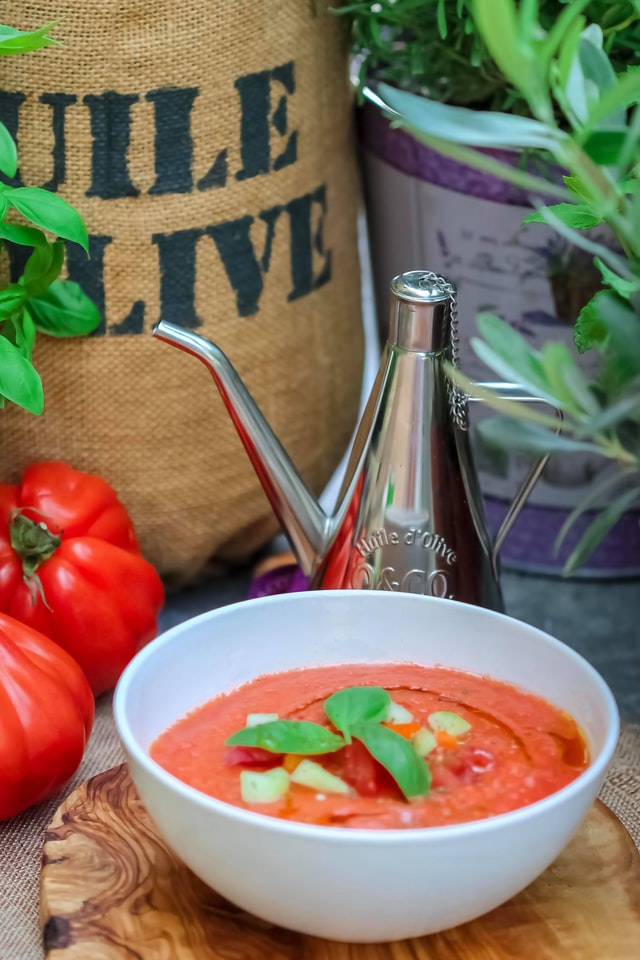
In terms of cooking technology:
1. Transparent soups
They consist of garnish and strong clear broths. These include: broth, consomme, uha, yurma, soup, danhuatan.
2. Filling soups
A distinctive feature of such soups is the presence of steamed vegetables. Many soups are filled with a cream of tomato puree. Shchi and borscht soups are sometimes topped up with a flour paste. The filling soups are: cabbage soup, borscht, rassolnik, minestrone, hodgepodge, bozbash.
3. Thickened soups
These soups are thickened with an ingredient during the cooking process:
- Flour (jor, some varieties of soup, borscht)
- An egg (guarded ear)
- Egg and egg sour dressing (chihirtma)
- Fermented dairy products (brinjoba)
4. Mashed potato soups

In the preparation of these soups, the ingredients are chopped up by mashing or other chopping methods: gazpacho, bisque. The base of these soups is a liquid white sauce in a broth of meat, fish, poultry, mushrooms or vegetables. Rice or barley broth or milk sauce can be used instead of white sauce.
Mashed soups based on broth are called slam soups, those based on milk sauce are called cream soups.
5. Roast soups
The ingredients for such soups are first fried and only then poured over the liquid. These include: shurpa (some types), katikli, bouillabaisse.
6. Combination soups
Soups typical of Far Eastern cuisine (China, Japan). The components of the soup are put into the broth directly on the table.
7. Sweet soups
Prepared from fresh, frozen and dried fruit and berries. These include fruit soups – served usually for dessert – and some types of milk soups. Sweet soups can be prepared with fruit and berry syrups, purees and extracts. Sweet soups are served with various side dishes.
8. Milk soups
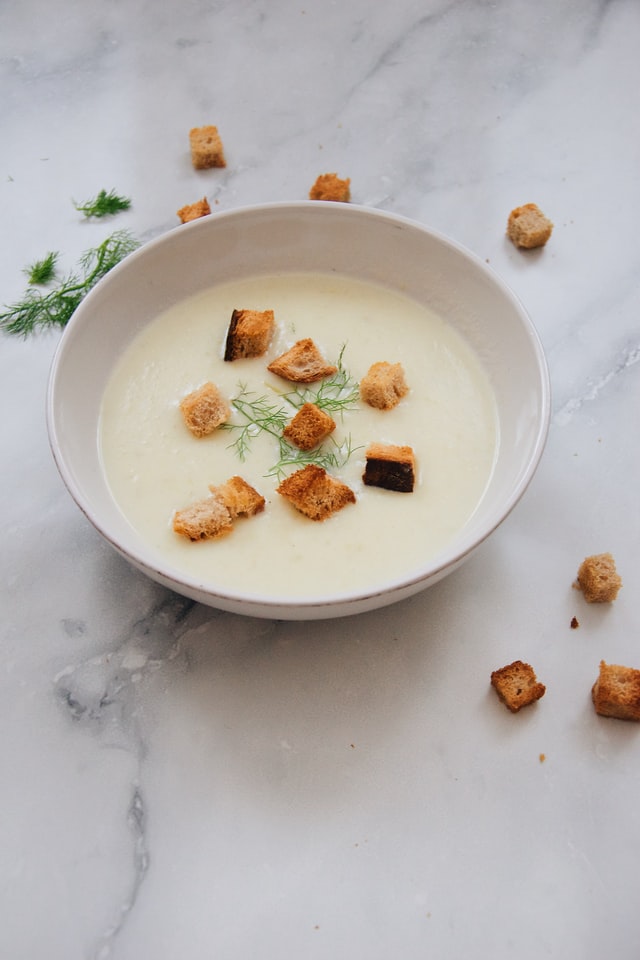
Cooked with whole milk or a mixture of milk and water, dried or sterilised condensed milk without sugar. Garnishes for soups are cereals – rice, millet, semolina, barley, hercules; pasta or flour products – noodles, dumplings, profiteroles; vegetables – pumpkin, turnips, courgettes, leeks, carrots, white cabbage, Brussels, Savoy cabbage, green peas, green beans.
By the cooking liquid used
Most soups are cooked with water or a mixture of water and other ingredients. The ingredients can be:
- kvass (chorba, okroshka),
- the beer is jelabrad (beer soup),
- milk (calakeitto and various milk soups),
- fermented dairy products (taratór, chłodnik, chalop, katykli, dovga, kakurum, brinchoba, spas),
- brine (kalya (can be partial),
- solyanka (in part),
- rassolnik (partially),
- wine (bouillabaisse (partly)),
- fruit (vegetable) juice (shechamandas).
By regional distribution:
The more popular main types of soup can be identified in each region. They are mostly prepared using the same technology.
1. Soups in Russian (Slavic) cuisine
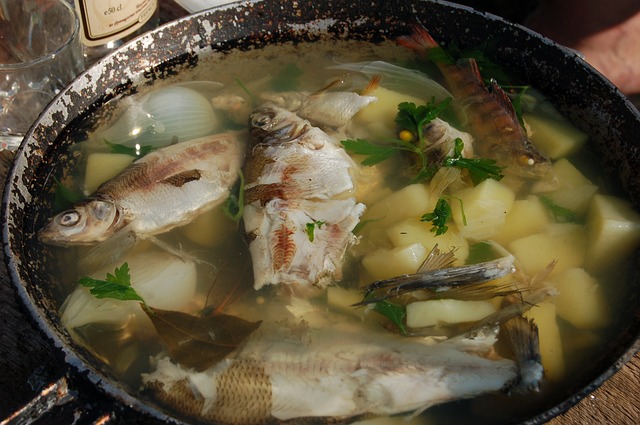
Russian cuisine is characterised by a wide range of different soups. Hot starter soups are widely used: cabbage soup, rassolnik, pea soup, chicken soup, and cold soups (okroshka). Of the other types of soups stand out ear. The filling soups are characteristic of the entire Eastern Europe.
2. Soups in Western European cuisine
Western European cuisine is characterised by clear soups and puréed soups. Many types of Western European soup are prepared according to the chowder principle – a one-part light vegetable broth. Such as onion soup, celery root soup. In Western Europe there are regions that make heavy, dense soups, typical of German and Czech cuisine. Almost all seaside regions have a distinctive cuisine – various seafood and fish soups are used.
3. Soups in Baltic cuisine
Baltic cuisine is quite varied in soups. In Lithuanian cuisine, filling soups (Lithuanian borscht) are also common. Latvian cuisine is poor in soups. Estonian and Finnish cuisine is characterised by a large variety of milk soups.
4. Soups in Central Asian cuisine
Central Asian cuisine, with it Kazakh and Kyrgyz, is characterised by roasting soups, peculiar cold and hot soups based on fermented milk products. In Central Asian regions cereals and dried fruits are actively used in soups. But in this cuisine, excluding Turkmen, fish soups are not common.
5. Soups in Transcaucasian cuisine
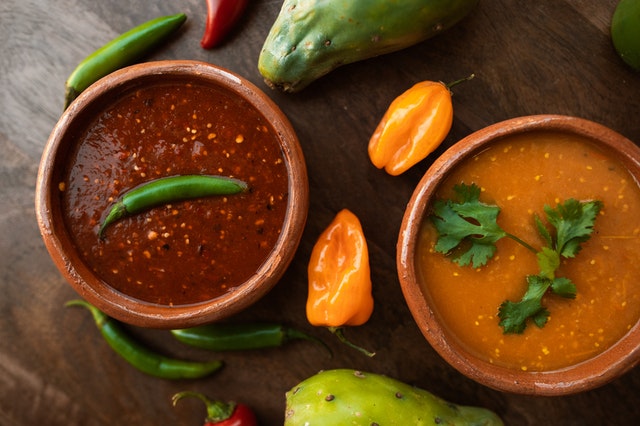
Transcaucasian cuisine is incredibly varied. In fact, there is only one filling soup in Georgian cuisine – kharcho. And there is a variety of thickened egg-sour soups (chhirtma). There are soups prepared with fruit juices (shechamandi on grated cornel). North Caucasian cuisine is similar to Tatar cuisine in many respects – they use flour products in clear soups. Armenian cuisine is characterized with filling soups with fruits and nuts. Azerbaijani cuisine is characterised by the preparation of dressing soups in pots.
6. Soups in Far Eastern cuisine
Japanese, Chinese and Korean cuisines, with their significant differences, are characterised by a combined method of soup preparation and the active (especially in Japan and not in all regions of China) use of fermented products (e.g. soybean paste). In Japan, Korea, Vietnam and coastal China the use of seafood and seaweed is common.
One of the staple dishes in the Japanese diet is miso paste soybean soup, misoshiru, which is eaten for breakfast almost every day.
Soup plays an important role in Korean cuisine. Korean soups are divided into transparent soups called kuk and opaque, thick soups called than. Kuk comes with noodles, ttok, seaweed, and mandu; than contains well-cooked meat (pork, beef, chicken) or seafood, as well as vegetables.
Pho soup with noodles and beef is one of the main dishes of northern Vietnam.
Examples of National Soups
- Bouillabaisse is a French fish soup. Similar soups exist in Italy, Ireland and Croatia.
- Demikat is a Slovak vegetable soup.
- Is-miine is a Yakut giblet soup. It should be noted that soup has only recently entered Polar cuisine.
- Kololik is an Armenian lamb soup.
- Consomme is a French soup (a type of broth) made from oxtails and shanks.
- Kidu is an African soup made from kidu fish.
- Kulesh is a Ukrainian soup made of lard and grits.
- Miso is a Japanese soup made from soybean paste.
- Oxtail soup is English oxtail soup.
- Borscht is a Slavic complex vegetable soup (with meat or vegetable broth).
- Shurpa is a thick soup among Turkic peoples.
- Kharcho is a Georgian beef soup with rice and walnuts.
- Khash is a Caucasian soup made from beef and/or lamb’s legs.
- Hogo is a Chinese soup made from vegetables and/or meat.
- Chilli con carne is a Mexican soup.
- Pho is Vietnamese noodle and meat soup.
- Tom yum/kung is a Thai hot and sour soup with shrimp, chicken, fish or other seafood.
- Pocinthang is Korean dog meat soup.
- Ahiaco is a Colombian soup made from chicken, corn, several types of potatoes and the guasca plant.
- Shchi is a Slavic complex vegetable soup (with meat or vegetable broth).
- Aletta – Maltese fish soup
Cooking and Types of Broths
Broth is a liquid broth made from meat, fish or vegetables.
There are three colours of broths – white, yellow and red.

Make white broth from uncooked meat and uncooked root vegetables. White broth is made from poultry.
Make the yellow broth from uncooked meat and roasted root vegetables – these are the main meat and bone broths for soups.
For a red broth, roast both the meat and the root vegetables. This kind of broth only comes with meat. Serve it alone or with a small amount of additional ingredients (broth with dumplings or dumplings).
Fresh broth is often used as a meal for illnesses. Liquid food is recommended for poisonings and digestive disorders.
You can serve the broth as a standalone dish or with a side dish. You can add cereals, bread, eggs and other items to the broth. Broth can also be used as a dressing for sauces of all kinds.
You can use bouillon cubes for cooking broths. In this case cook the soups in water without adding salt. Dissolve the cubes in a small amount of hot water and add them to the soup 15-20 minutes before it is ready.
Broths come in these varieties:
- bone,
- meat and bone,
- of poultry,
- fishy,
- mushroom,
- concentrated.
Bone broth
Use the bones when making the broth:
- beef (articular heads of the tubular bones, thoracic, vertebral and sacral bones);
- pigs and sheep (thoracic, vertebral, pelvic, tubular and sacral bones).
Chop the bones into pieces (5-7 cm) for more nutrients. Chop the joint heads of the tubular bones into several pieces, leave the tubes intact.
Roast the beef bones and pork bones slightly in the roaster – for better flavour and appearance of the stock. Pour cold water over the bones and simmer gently. Be sure to skim off the foam and fat from the surface of the broth. Broth boiling time is 3.5-4 hours for beef bones and 2-3 hours for pork and lamb bones. Prolonged cooking impairs the taste and aroma of the broth.
For broth quality and flavour – 30-40 minutes before the end of the cooking time, put the fat-free carrots and onions and salt into the broth. You can add parsley, celery, dill stalks, carrots and onions to the broth. Make sure to strain the broth when ready.
Meat and bone broth
It is prepared in the same way as bone broth.
Put the pieces of meat in 2-3 hours before the end of the cooking time. This will add flavour to the broth and the meat. And the broth turns out transparent.
Poultry broth
Boil the broth from bones, offal (heart, stomachs, neck, head, legs, wings, neck skin) or whole bird carcasses. Chop the bones into small pieces. Pour cold water over the bird carcasses. Bring to the boil and cook at a gentle simmer for 1 to 2 hours.
Skim off the foam and fat as it cooks. 30-40 minutes before the broth is ready, add the carrots and onions to the broth. Sieve the broth when ready.
If using bones, offal and whole carcasses at the same time, boil the bones and offal first and the whole carcasses later, depending on their cooking time.

Fish broths
For these broths, use food waste (heads, bones, skin, fins). These remain when processing fresh or freshly frozen fish.
Remove the gills from the heads and the eyes from large heads. Cut large heads and vertebral bones into pieces. Pour cold water over the food waste, bring to the boil, skim off the foam on the surface of the broth. Add onions and simmer for 40-50 minutes at a gentle boil. Strain the broth when ready.
When cooking sturgeon broth, remove the heads after one hour of cooking. Separate the flesh and chop the gristle. Pour in a small amount of broth, bring to the boil and use for dishes.
Fish such as roach, plaice, bream, carp, roach and redfin are not suitable for broths. For fish broths, apart from food waste, fish of the fatty variety or less fatty for diet broth is used.
Mushroom broth
A broth of dried mushrooms is boiled.
Soak the mushrooms in cold water for 10-15 minutes. Rinse them well and pour water over them again and leave them to swell for 3 to 4 hours. Rinse the swollen mushrooms and cook them in the water they soaked in. Rinse the water off beforehand. Rinse the boiled mushrooms and strain the stock.
In addition to the traditional way of cooking broth, there are new techniques. The broth is more flavourful and not too stiff. For this, cook the mushrooms at a low boil. There is no need to soak the mushrooms.
Concentrated broth
A concentrated meat and fish broth is a broth with a yield of 1L from 1kg of bones, meat products or edible fish waste. Concentrated broths can be diluted to the desired volume.
Soup Cooking Ideas
Meat and poultry soups

Chicken stock is the basis for a huge number of dishes: first, second and even sauces. You can use it as a standalone dish and as a base for soups. It is healthy, light and nutritious.

The specific aroma is created by a small amount of lime. The soup is full of summer freshness with an incredible broth. Cinnamon, cloves, allspice, bay leaves, black pepper and oregano create an extraordinary combination of flavours. The chilli pepper adds spice to the dish. The excessive spiciness of the soup is muffled by its citrus ingredients: lime and grapefruit juice and added acidity, balancing the taste.

Smooth texture combined with almonds, sweet, creamy flavour, light garlic flavour. You will definitely be surprised by this recipe. The combinations of simple ingredients create an amazing flavour. The smell of garlic leaves absolutely no trace.

Sorpa is also called shurpa, shorpo, chorpa. It is a tasty and filling oriental dish. It is a thick and hearty soup. Boil it with lamb, chop vegetables coarsely, add fragrant spices and herbs. You can replace the lamb with beef.

Use kvass in this recipe for meat ocrochka. You can substitute the ingredients to your liking – use any type of sausage, different types of meat and smoked meat, add radishes and dill. Okroshka can be meat, sausage or vegetarian. Okroshka is made with kvass, water or kefir. It’s a very simple dish and doesn’t require any cooking skills.

A very tasty pea soup. Prepare it in a pork leg broth. It is rich, flavourful and hearty. Hunting sausages give the soup a nice, subtle smoked flavour. You can replace the sausages with smoked ribs.

The soup includes roast beef, sausages and mushrooms. All this variety of delicious ingredients is complemented by tomato, peas and lingonberries. An extraordinary combination of flavours and incredible nourishment from this soup.

This soup is also called ‘Old Man’. It’s best to make it when it’s cold. Instead of meat bones and bacon, you can use giblets when cooking. Add sauerkraut, potatoes, garlic and spices to the soup. Add sausage or bacon for a richer flavour.

A wholesome and vitamin-rich soup. It tastes slightly sour. For this soup you can use chicken fillet, as in this recipe, or parts of chicken or pork. You can serve it hot or cold.

A beetroot soup with the perfect combination of traditional and original. Silky beetroot broth, potatoes and fresh cucumber – cut into traditional straws. The originality is given by boiled veal, soy sauce and Japanese mitsukan rice vinegar.

Extraordinarily delicious kharcho soup with flavours of Georgian herbs and spices. The most popular and best soup in Caucasian cuisine. In this soup all ingredients complement each other, saturate with flavour and healthy qualities, moderately spicy and nutritious.

Polish traditional Easter soup. Zurek is a sour soup. You can make it without bacon, which makes it look like a Lenten dish. An interesting and unusual dish.

A fresh and nutritious, low-carb soup. Avgolemono is a Greek chicken soup. Prepare it with rice (or orzo), chicken, vegetables, eggs and plenty of lemon and fresh herbs. The soup is incredibly flavourful, rich in nutrients and healthy.

An incredibly tasty soup. You could call this soup a variant of French fish soup. It’s a wonderful combination of flavours, and the sauce adds a touch of spice and tenderness. The soup is light and nutritious at the same time.

A healthy, low-carb, inexpensive clear soup. The green turnip leaves fill out the look of the soup beautifully and add freshness. You can replace the sausage with chicken or beef. A healthy soup.

A thick, rich Italian soup. You can add any vegetables, legumes and pasta. Traditionally onions, carrots, celery, garlic and tomatoes are used. You can make this soup vegetarian by removing the bacon.
Fish soups

There are no exotic ingredients in this soup. Buckwheat noodles can be replaced with rice noodles or Chinese wheat noodles. The broth adds flavour and richness to the soup. Salmon complements the flavours of this soup perfectly.

A nutritious and healthy salmon soup. You can use fish broth, chicken broth or vegetable broth. The prawns add a spicy touch to the soup.

Milk and creamy fish soup. Light, rich and healthy. This soup can be made with carp, smelt, saffron cod, cod, zander, chum salmon and other fish.

The soup has a distinct cheese flavour, but there is no cheese at all. In general, the taste is very rich, with interesting notes. The cream completely overpowers the fishy aroma. This soup is quick to prepare.

Fish soup in the Marseille style. Have a variety of sea fish. The more varieties, the tastier the soup will be. Serve the soup with garlic croutons fried in olive oil.

Tender fish soup with fresh tomatoes and crispy onions. A combination of the taste and aroma of smoked fish, refreshed with lemongrass and ginger, the sourness of tomato and the hotness of red pepper. An interesting and unusual soup. It’s perfect for your festive table.
Vegetable soups

The onion flavour changes from harsh and bitter to sweet and creamy during cooking. The soup is light, tasty and hearty. Cream and milk can be omitted.

Lentil soup is a popular dish in national Turkish cuisine. The soup is very quick to prepare. It is very nutritious, flavourful and rich. The butter can be replaced with vegetable oil.

A delicious thick bean soup will grace any dinner table. Serve with tortillas or black bread, topped with sour cream. Nutritious and healthy soup. A great option for a dietary menu.

Creamy roasted red pepper and tomato soup. This recipe is vegetarian and gluten-free. It’s hearty and rich and comes with just five ingredients. All the ingredients can be cooked on the stovetop, in the oven or on the grill.

A delicious and simple curry soup. Add broccoli florets and some leeks and some glass noodles to the soup. The soup is nutritious and very healthy. For days of detox and diets, this soup is a godsend.

This soup is easy to make. All the ingredients are definitely in your fridge. The beautiful and appetising appearance of this soup will win you over. You can add some sesame oil, sesame seeds or some chopped walnuts to the soup.

The perfect recipe for vegan black bean soup. The soup is very healthy, light and delicious. You can use canned beans.

The sweet corn goes well with the rest of the soup ingredients. This soup will brighten up your dinner. Spice it up with fresh basil and jalapeño pesto sauce. Serve together with tomato spread on ciabatta bread. Save a spoonful of fresh corn kernels for garnishing – they will add a nice crunch to the creamy soup.

Pumpkin soup is creamy and smooth, with a little sweet spice, and very healthy. The pumpkin for this dish needs to be baked. A great option for an autumn menu.

Fans of unsweetened snack biscuits will be delighted. It’s tangy, rich, as a snack, or a light snack, or as an accompaniment to soups. This vegetable soup is vitamin packed. A light and tasty soup.

A variation on the summer broccoli cream soup. Light, tender, silky and delicious. Serve the cream soup cold or at room temperature. A refreshing and tonic soup.
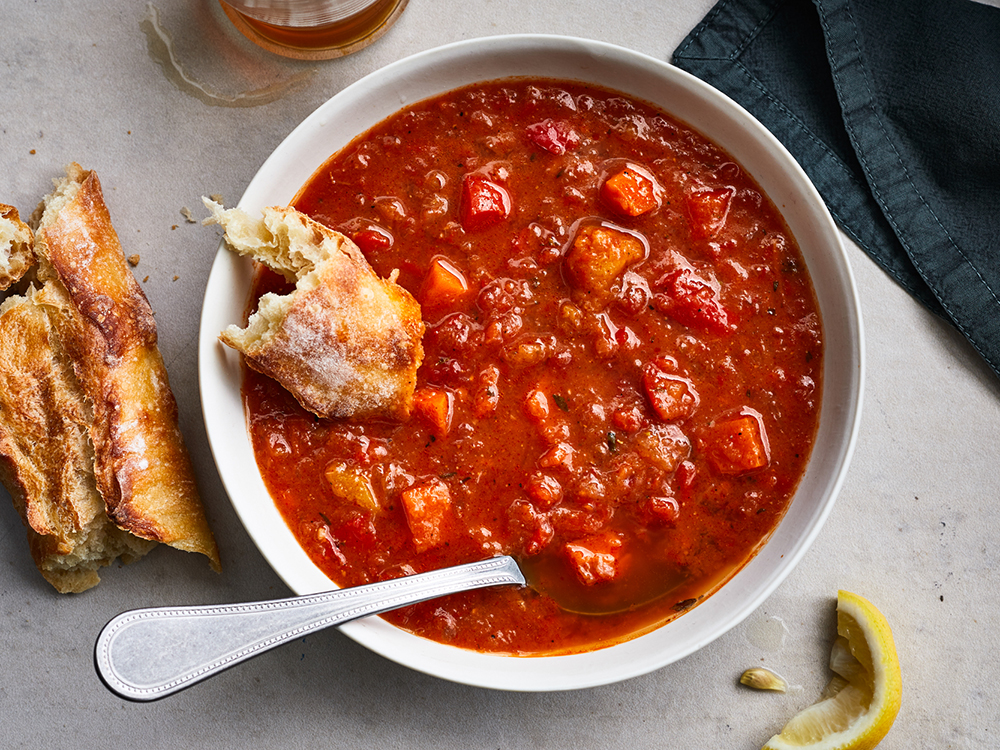
Red bell peppers, carrots, onions and pumpkin – roast in the oven. The soup is deep and rich, without broth, with the addition of miso, soy sauce, canned tomatoes and smoked paprika. The vegetables in the soup are caramelized, tender, and sweet. A hearty, fully complex soup, extraordinarily flavourful, healthy and vegetarian.
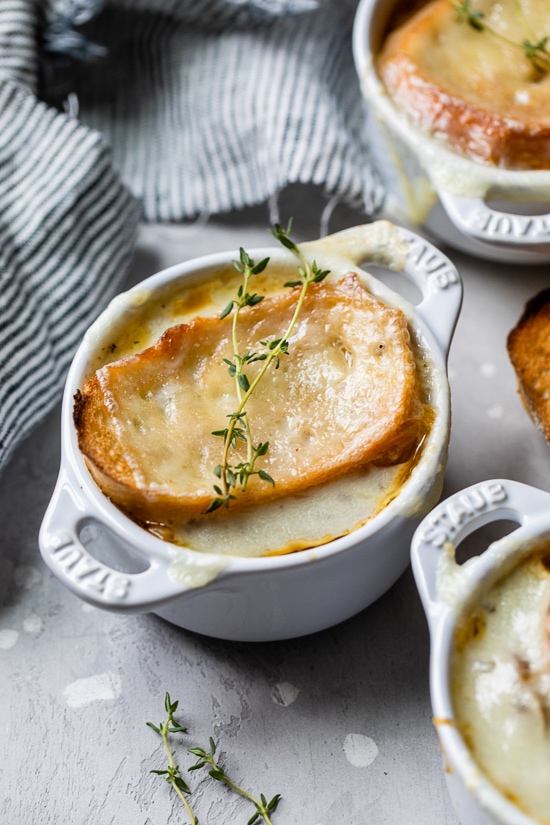
A very tasty and hearty dish. Perfect for a winter family meal. It is made with beef stock. You can use yellow, white, shallots or red onions. Serve this soup with a slice of bread and cheese.

Sorrel soup is a traditional green borscht. It is prepared mainly with broth, sorrel leaves and salt. Sorrel soup can be called ‘sour soup’. Sorrel leaves are very spicy and sour. You can eat vegetarian borscht cold in summer – it will be a refreshing drink.
Mushroom soups

Mushroom soup contains a huge amount of protein. The mushroom soup is flavourful and tender. It is very hearty and tasty. It is better to consume such a dish freshly cooked. If reheated, it loses its rich flavours.

Porcini mushroom soup is a gourmet first course. The noble mushrooms give the broth a rich flavour and a unique aroma. The recipe for mushroom soup is simple and doesn’t take long to prepare.
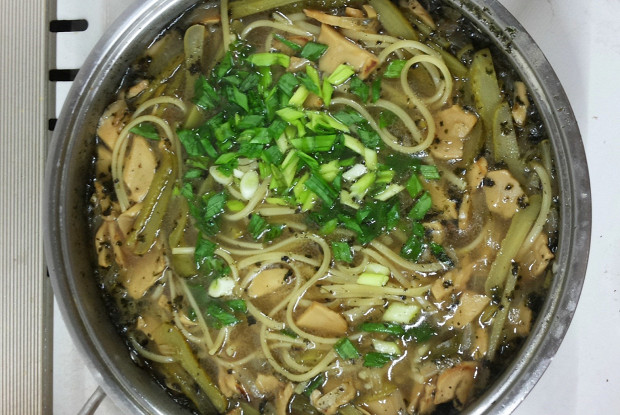
Wok fry all the soup ingredients in the wok. Boil the soup in chicken or meat broth for a richer flavour. Use whatever mushrooms you prefer.

This soup is made with pork rib broth and is very fragrant and filling. The prunes give the broth a certain characteristic flavour, and the sauerkraut adds a slight sourness. Millet makes kapustnyak thick and hearty.
Cereal soups

You can make garlic chickpea soup with just 4 simple ingredients. But it tastes rich, is nutritious and full of nutrients. It tastes great hot and cold. Ideal for dietary and vegetarian menus. Chickpeas are a valuable source of protein and therefore a complete substitute for meat. It is also rich in phosphorus, potassium, iron and other useful trace elements.

Quinoa is a traditional South American grain crop. When cooked, it tastes like brown rice. Quinoa can be added to salads, meat dishes and soups. Quinoa is rather spicy. Add avocado to make it fresh and less spicy.

A wonderfully tasty and hearty soup with lentils and wheatgrass. You can use bulgur. Carrots and tomatoes give the soup a delicate flavour. Cumin seeds and garlic – create an unusual spice.

You can use beef stock, chicken stock or vegetable stock as the base for this soup. The sauteed vegetables combined with tomatoes, buckwheat and dried herbs give the soup a complex flavour and a slightly spicy aroma. You can add any spices you like to your own taste.

A classic first course with meat and potatoes. This meatball and rice soup is very easy to make. You can adjust the thickness and ingredients to suit your own tastes and preferences. You can use any kind of meatball stuffing: pork, beef, mixed or chicken.

Rice soup with smoked ribs is a simple and delicious first course for a family meal. It should preferably be made as a one-off, so that it does not become too thick the next day from the swollen rice. The smoked ribs make a very tasty and hearty soup.
Dairy and cheese soups

A marvellous mashed potato and melted cheese soup. Garlic occupies a special place here. The garlic, stewed in clarified butter, gives the dish a unique flavour and aroma.

A quick-to-make, refreshing, creamy cream soup. This spinach soup recipe is a good way to incorporate spinach into your diet. It turns out a bright, rich green colour. It is very light and tasty. You can hardly taste the spinach in it.

The soup is full of the rich and creamy flavour of roasted garlic and cauliflower. It’s perfect for winter family dinners . The dish is made from simple ingredients. It is dairy-free and gluten-free.

The soup is a little creamy, but not too thick. If you want it to be thicker – add less vegetable broth. Spinach – try replacing it with cabbage, use nutmeg instead of carrots. You can add mushrooms and celery, also a good combination.

Creamy vegetable soup. An unusual addition is the coconut cream. All the combinations of ingredients in this soup create a bouquet of flavours, wholesomeness and nutrition.
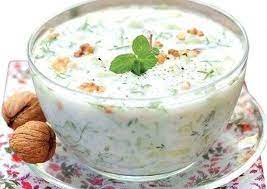
A vitamin-rich, refreshing soup. Main ingredients: sour milk (unsweetened liquid yoghurt), cucumbers, garlic, walnuts, dill, vegetable oil (often olive oil), water, salt, spices. You can serve it with ice. Instead of sour milk you can use water acidified with vinegar. Replace the cucumbers with green salad.

This soup is light and hearty and very healthy. You can also serve it as a non-vegetarian soup – sprinkle it with crispy fried bacon. Add the feta to the soup when serving and sprinkle chopped herbs or crisps on top.
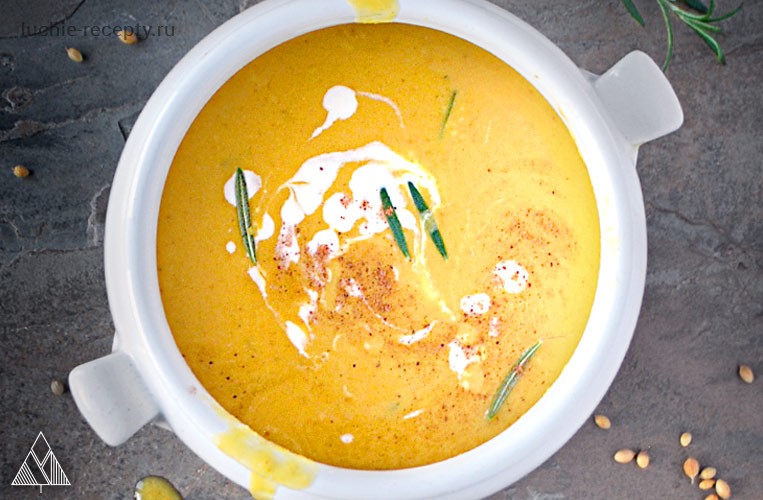
A tasty and healthy dish. The best soup option for winter time. Pumpkin is rich in vitamins and is excellent for supporting the immune system. The puree soup is beautifully coloured and deliciously flavoured.
Seafood soups

A delicate and deliciously creamy soup. The seafood mix adds a twist to this soup. It’s a great option for a diet menu. A healthy and nutritious soup.

A healthy, tasty, colourful soup with an exotic twist. If you’re craving a hot, rich soup, this recipe is for you. It’s quick and easy to make and has a minimum of calories.

The legendary Thai tom yum soup with prawns. You can make this soup with different additions (seafood, chicken, etc.). You can choose the spiciness of the soup according to your taste. A tangy and unusual dish.

Use a seafood cocktail for this soup. Basil, saffron and spices infuse the seafood perfectly with flavour. A tomato base with tomato and sweet peppers infuses the soup with flavour. A slight sourness from the lemon juice gives an interesting touch to this dish.

This soup has all the essential ingredients of Spanish cuisine: olive oil, garlic, aromatic wine and seafood. The spicy tomato base creates a unique, rich flavour. The seafood is tender and succulent.
Fruit soups

Melon soup is a Spanish recipe. It contains ripe melon pulp, cucumber and yoghurt. Simple, quick and easy to prepare. Pour the soup into melon halves and garnish with grapes.

An unusual sweet soup. A great way to surprise your loved ones with this dish. The children will love this soup. It is very healthy and full of vitamins.
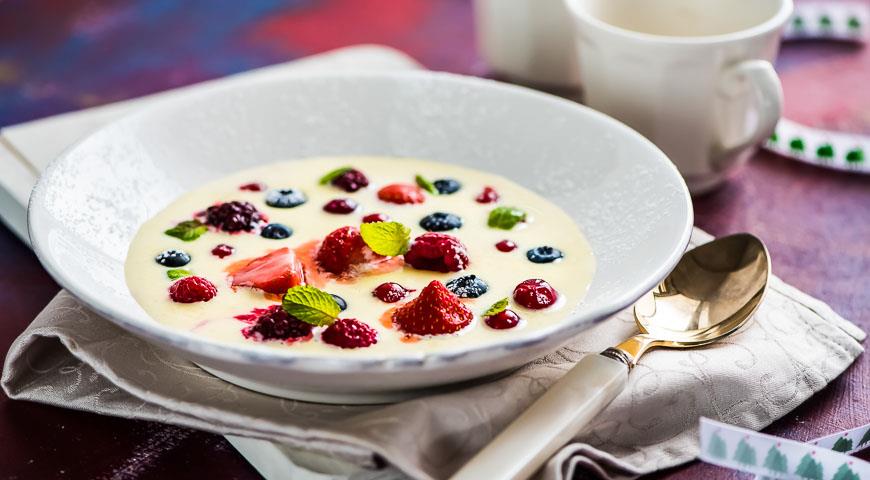
A deliciously sweet soup. You could even call it dessert. You can use frozen berries and replace the white chocolate with milk or dark chocolate. Use as many berries as you like.

A healthy and vitamin-rich soup. It’s more like a compote with apricots and sultanas. Serve it cold or warm. Try adding sour cream to it.
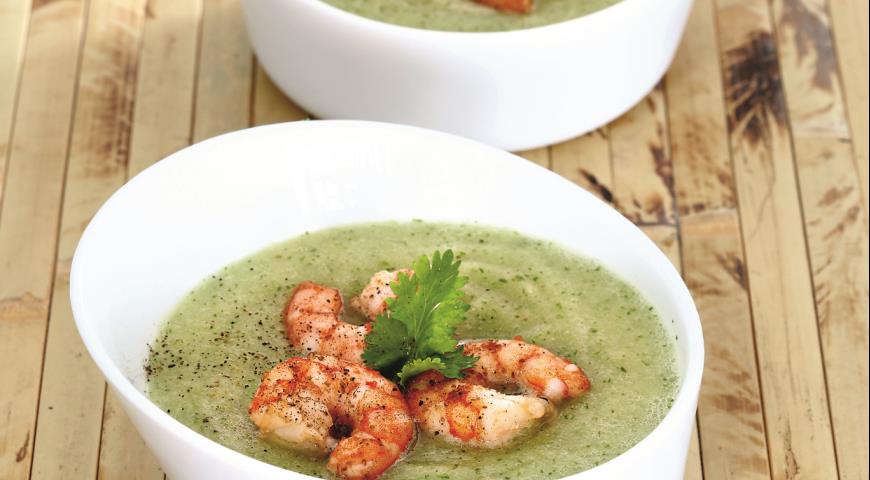
Seemingly incompatible ingredients, yet create an extraordinary taste in soup. Serve the soup cold. With a blender, whisk all the ingredients together. Ginger, lime and cilantro add freshness and sourness to the soup. Try an unusual and original fruit soup.

Original fruit goulash soup is a great way to diversify your daily menu. This dish is made with pork with onions, red peppers, preserved peaches and aromatic fresh thyme leaves. The soup is delicious and fragrant. You can serve the finished soup as a first or second course, or as a sauce for pasta.
Soups made from flour products
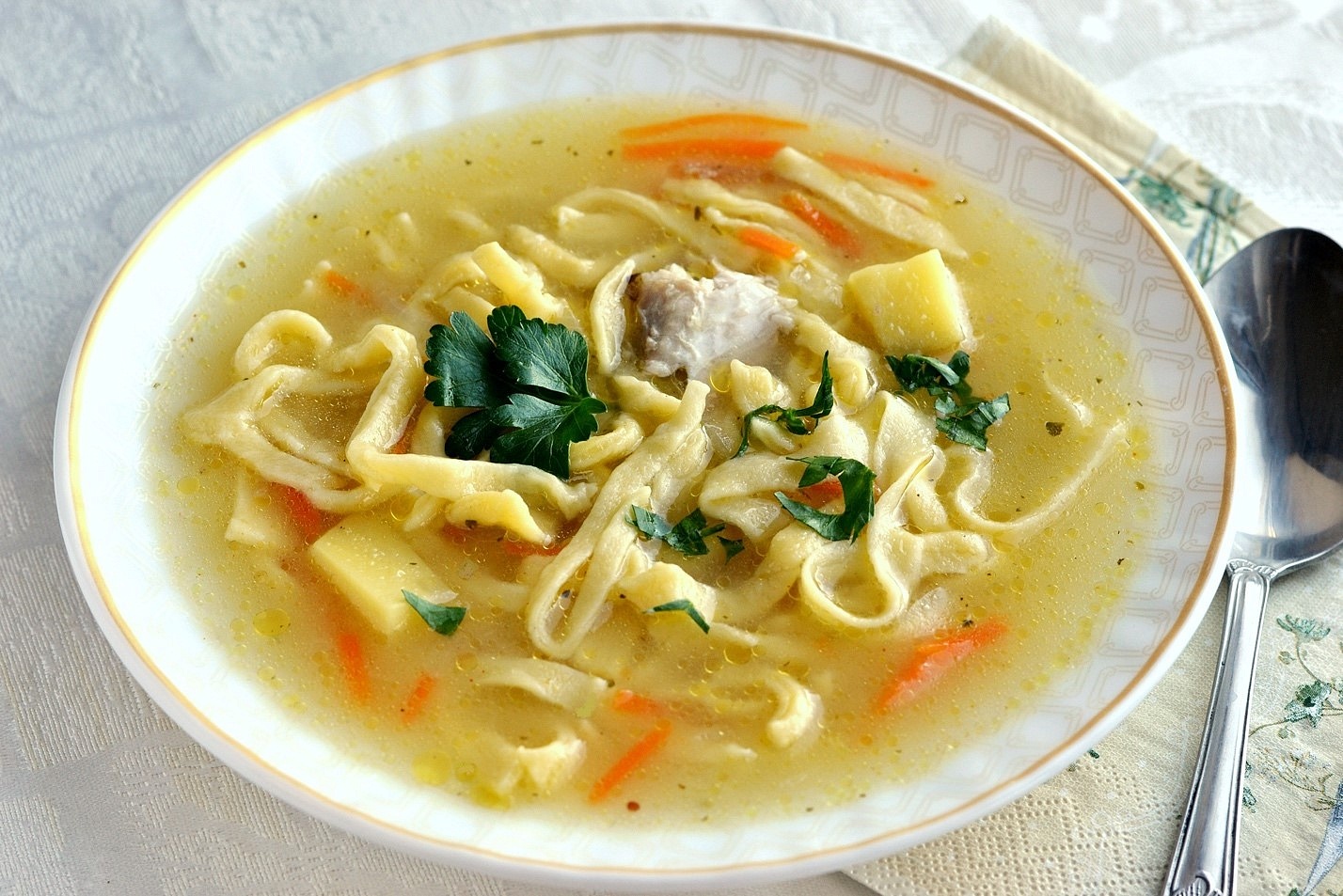
A delicious, nutritious, flavourful and rich soup. Homemade noodles add flavour and richness to the chicken broth. Delight your loved ones with a delicious soup.

A light and flavourful Korean-style soup. Use ramen noodles, fresh herbs, hard-boiled eggs and kimchi. It is a tasty and quick soup. It only takes 30 minutes to prepare. Kimchi is a traditional Korean side dish of pickled and fermented vegetables – cabbage, Korean radish, with various seasonings.

An unusual and delicious soup. The highlight of this soup are the potato dumplings. The ham complements the flavours of the dish. A hearty and nutritious soup that is sure to please.
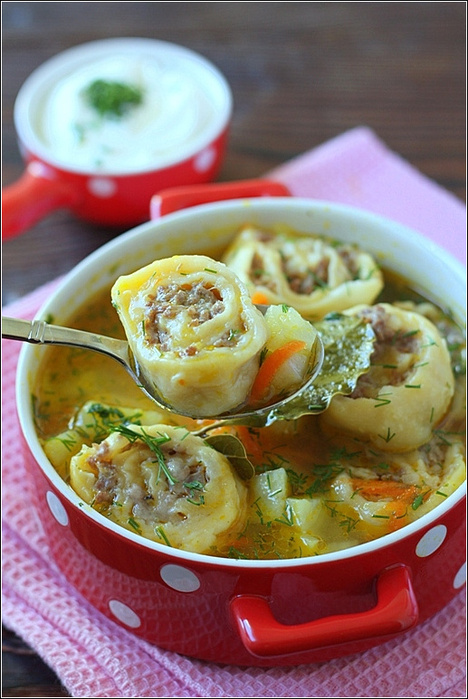
A very hearty and nutritious soup. For lovers of dumplings, it’s a varied way of serving them. This soup actually combines two dishes together – soup and dumplings. The unusual presentation and incredible flavour will make this soup your favourite.
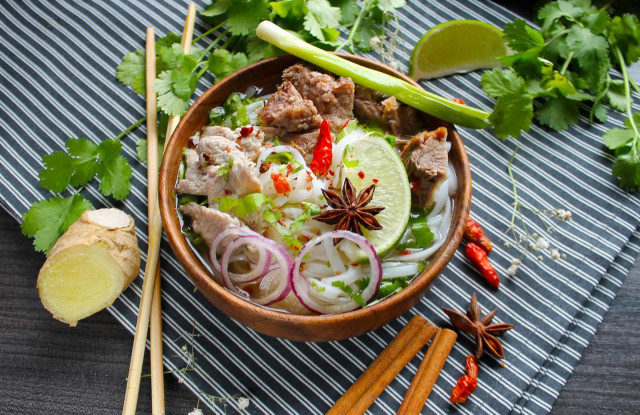
Spicy, flamboyant, with lots of spices. Pho Bo Classic is a Vietnamese soup. It consists of rice noodles, beef meat, a rich broth and herbs. The longer the broth cooks, the better the soup will be.
